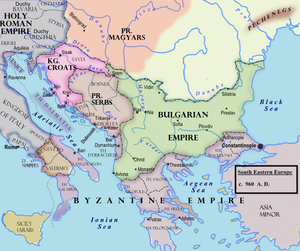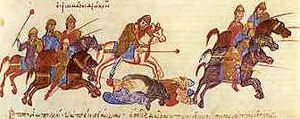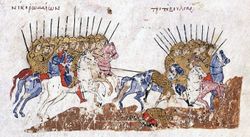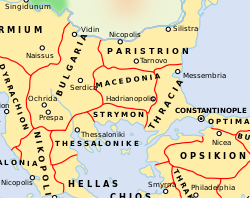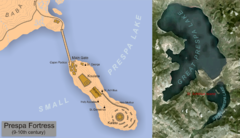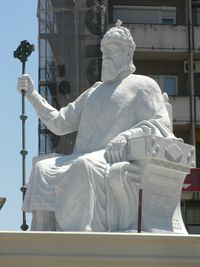صمويل من بلغاريا
| صمويل Samuel Самуил | |
|---|---|
| قيصر بلغاريا | |
 اعادة تشكيل الوجه بناءاً على رفاته. | |
| العهد | 997 – 6 أكتوبر 1014 |
| سبقه | رومان |
| تبعه | گاڤريل رادومير |
| توفي | 6 أكتوبر 1014 پرسپا,[1] الامبراطورية البلغارية الأولى (بلدة غير معروفة تقع حالياً على حدود پرسپ، التي تتشارك حدودها مع مقدونيا، ألبانيا واليونان) |
| المدفن | |
| Spouse | أگاثا |
| الأنجال | گاڤريل رادومير ميروسلاڤا |
| الأسرة | الكومتوپولية |
| الأب | نيكولاس |
| الأم | ريپسيميا من أرمنيا |
| الديانة | أرثوذكسية بلغارية |
صمويل[2] (أو صموئيل، تُكتب بالبلغارية Самуил، وُتنطق [samuˈil]، الكنيسة القديمة: قالب:Slavonic)، كان قيصر (امبراطور) الامبراطورية البلغارية الأولى من 997 حتى 6 أكتوبر 1014.[3] من 977 حتى 997 كان جنرالاً تحت قيادة رومان الأول من بلغاريا، ثاني أبناء الامبراطور پطرس من بلغاريا، وشارك معه في حكم البلاد، حيث منحه رومان قيادة الجيش وسلطة ملكية نافذة.[4] ولكونه ناضل من أجل الحفاظ على استقلال بلاده عن الامبراطورية البيزنطية، تميز حكم صمويل بالحرب الدائمة ضد البيزنطيين وحاكمهم الطموح باسيل الثاني
أثناء السنوات الأولى من حكمه تمكن صمويل من إلحاق العديد من الهزائم الكبرى بالبيزنطيين وشن حملات هجومية في أراضيهم.[5] في أواخر القرن العاشر، غزت الجيوش البلغارية إمارة دوكليا الصربية[6] وقاد حملات ضد مملكتي كرواتيا والمجر. لكن من عام 1001، أُجبر على الدفاع عن الامبراطورية ضد الجيوش البيزنطية المتفوقة. توفي صمويل بأزمة قلبية في 6 أكتوبر 1014، بعد شهرين من معركة كليديون الكارثية. فشل خلفائه في تنظيم مقاومة، وفي 1018، بعد أربع سنوات من وفاة صمويل، استسلمت البلاد، منهية خمسة عقود من النزاع البلغاري البيزنطي الطويل..[7]
اعتبر صمويل "ذو سلطة لا تقهر وقوة لا يمكن التغلب عليها".[8][9] وردت نفس التعليقات في القسطنطينية، حيث نظم جون كيريوتس قصيدة تقارن بين الامبراطور البلغاري والمذنب هالي، الذي ظهر عام 989.[10][11]
أثناء حكم صمويل، فازت بلغاريا بالسيطرة على معظم البلقان (مع أشهر توسع في تراقيا) جنوباً حتى اليونان. نقل العاصمة من سكوپيه إلى أوهريد،[5][12] والتي كانت مركزاً ثقافياً وعسكرياً لجنوب غرب بلغاريا منذ عهد بوريس الأول،[13] وجعل المدينة مقعداً للبطريركية البلغارية. من أجل هذا، يطلق على مملكته أحياناً امبراطورية غرب بلغاريا.[14][15]
أعاد حكم صموئيل المفعم بالنشاط القوة البلغارية في البلقان، وعلى الرغم من أن الإمبراطورية لم يعاد تأسيسها بعد وفاته، إلا أنه يُعتبر حاكمًا بطوليًا في بلغاريا.[16][17]
كما يعتبر صمويل حاكماً بطولياً في مملكة مقدونيا؛ [18] (انظر قسم التسمية).[19]
. . . . . . . . . . . . . . . . . . . . . . . . . . . . . . . . . . . . . . . . . . . . . . . . . . . . . . . . . . . . . . . . . . . . . . . . . . . . . . . . . . . . . . . . . . . . . . . . . . . . . . . . . . . . . . . . . . . . . . . . . . . . . . . . . . . . . . . . . . . . . . . . . . . . . . . . . . . . . . . . . . . . . . . .
صعود أسرة كومتوپولي

أسرة كومتوپولي
غزو الروسء وخلع بوريس الثاني
الحروب مع بيزنطة

الحكم المشترك مع رومان
الامبراطور
الحرب ضد الصرب والكروات
التقدم مع البيزنطيين
الحرب مع المجر

المزيد من النجاحات البيزنطية
كارثة عند كليديون
. . . . . . . . . . . . . . . . . . . . . . . . . . . . . . . . . . . . . . . . . . . . . . . . . . . . . . . . . . . . . . . . . . . . . . . . . . . . . . . . . . . . . . . . . . . . . . . . . . . . . . . . . . . . . . . . . . . . . . . . . . . . . . . . . . . . . . . . . . . . . . . . . . . . . . . . . . . . . . . . . . . . . . . .
العائلة، القبر والذكرى
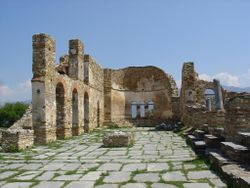
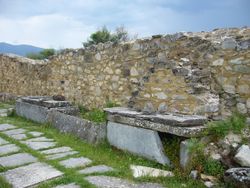

التسمية
انظر أيضاً
- الحروب البلغارية البيزنطية
- الحروب البلغارية المجرية
- الحروب البلغارية الكرواتية
- الجيش البلغاري في العصور الوسطى
- أسرة كومتوپولي
- نقش بيتولا
- نقش صمويل
- الأرمن في بلغاريا
الهوامش
- 1. Bulgarian ъ can be transliterated a, u, or sometimes â, as in български, balgarski (as below) or bulgarski.
- 2. The work of Vasil Zlatarski, History of the Bulgarian state in the Middle Ages has three editions. The first edition is from 1927 published in Sofia; the second edition is from 1971 and can be found here [1] in Bulgarian; the third edition is from 1994 published in Sofia, ISBN 954-430-299-9
المصادر
- ^ Southeastern Europe in the Middle Ages, 500-1250, Florin Curta, Cambridge University Press, 2006, ISBN 0521815398, p. 242.
- ^ Spelled thus in Fine, The Early Medieval Balkans; also Ostrogorsky, Treadgold, opp. cit., Oxford Dictionary of Byzantium. In French, compare Adontz, Nicholas. "Samuel l'Armenien, Roi des Bulgares", in Études Arméno-Byzantines. Lisbonne: Livraria Bertrand, 1965, pp. 347-407.
- ^ A History of the Byzantine state and society, Warren Treadgold, Stanford University Press, 1997, ISBN 0804726302, p. 871.
- ^ One theory is that from 972/976 to 997 Samuel co-ruled with Roman I of Bulgaria, who was the official tsar until 997, when he died in Byzantine captivity. Roman is mentioned as tsar in several historical sources; for example the Annals by Yahya of Antioch call Roman "Tsar" and Samuel "Roman's loyal military chief". However, other historians dispute this theory, as Roman was castrated and so technically could not have claimed the crown. There was also a governor of Skopje called Roman who surrendered the city to the Byzantines in 1004, receiving the title of patrician from Basil II and becoming a Byzantine strategos in Abydus (Skylitzes-Cedr. II, 455, 13), but this could be a mere coincidence of names.
- ^ أ ب "Samuil of Bulgaria". Archived from the original on 2007-02-21. Retrieved 2008-05-23.
{{cite web}}: Unknown parameter|deadurl=ignored (|url-status=suggested) (help) - ^ "Britannica Online – Samuel of Bulgaria". Retrieved 2008-05-23.
- ^ Whittow, Making of Orthodox Byzantium, pp. 387-388.
- ^ Stephenson, P., The legend of Basil the Bulgar-slayer, p. 16, ISBN 0-521-81530-4
- ^ Sullivan. D. F., ed. and tr., The life of St Nikon, Brookline, 1987, pp. 140-142.
- ^ خطأ استشهاد: وسم
<ref>غير صحيح؛ لا نص تم توفيره للمراجع المسماةpoe - ^ Schlumberger, G, L'épopée byzantine á la fin de dixiéme siécle, 1. Jean Tzimisés; les jeunes années de Basile II, le tueur de Bulgares (969-989), Paris 1896, pp. 643-644.
- ^ خطأ استشهاد: وسم
<ref>غير صحيح؛ لا نص تم توفيره للمراجع المسماةenc - ^ "About Ohrid". Retrieved 2008-05-23.[dead link]
- ^ The Decline and Fall of the Roman Empire, Edward Gibbon, J. B. Bury, Wildside Press LLC, 2004, ISBN 0-8095-9240-1, p. 142.
- ^ A short history of Yugoslavia from early times to 1966, Stephen Clissold, Henry Clifford Darby, CUP Archive, 1968, ISBN 0-521-09531-X, p. 140
- ^ Andreev, J. The Bulgarian Khans and Tsars (Balgarskite hanove i tsare, Българските ханове и царе), Veliko Tarnovo, 1996, p. 127, ISBN 954-427-216-X
- ^ "Bulgaria after Simeon". Archived from the original on February 5, 2008. Retrieved 2008-02-12.
{{cite web}}: Unknown parameter|deadurl=ignored (|url-status=suggested) (help) - ^ There has been no Macedonian state since the days of the Ancient Macedon that was finally abolished in 148 BC and 1945, when Communist Yugoslavia established its constituent republic with such name. It is unlikely that the contemporary Republic of Macedonia founded in 1991, may establish credible historical link to the medieval Samuel's state. According to Encyclopedia Britannica, Columbia Encyclopedia, Collier's Encyclopedia, the Great Russian Encyclopedia, Oxford Dictionary of Byzantium and the Cambridge Medieval History, Samuel was Tsar of Bulgaria.
- ^ "Until the late 19th century both outside observers and those Bulgaro-Macedonians who had an ethnic consciousness believed that their group, which is now two separate nationalities, comprised a single people, the Bulgarians. Thus the reader should ignore references to ethnic Macedonians in the Middle ages which appear in some modern works. In the Middle ages and into the 19th century, the term ‘Macedonian’ was used entirely in reference to a geographical region. anyone who lived within its confines, regardless of nationality could be called a Macedonian...Nevertheless, the absence of a national consciousness in the past is no grounds to reject the Macedonians as a nationality today." See: John Van Antwerp Fine, "The Early Medieval Balkans: A Critical Survey from the Sixth to the Late Twelfth Century," University of Michigan Press, 1991, ISBN 0472081497, pp. 36–37.
- ^ خطأ استشهاد: وسم
<ref>غير صحيح؛ لا نص تم توفيره للمراجع المسماةdelev
المراجع
- Adontz, Nicholas (1965). "Samuel l'Armenien, Roi des Bulgares". Études Arméno-Byzantines (in الفرنسية). Lisbonne: Livraria Bertrand.
- Andreev, Jordan; Milcho Lalkov (1996). The Bulgarian Khans and Tsars (in Bulgarian). Abagar. ISBN 954-427-216-X.
{{cite book}}: CS1 maint: unrecognized language (link) - Cheynet, J.-Cl. (1990). Pouvoir et contestations a Byzance (963-1210)e (in French). Paris.
{{cite book}}: CS1 maint: location missing publisher (link) CS1 maint: unrecognized language (link) - Delev, Petar; Valeri Katsunov; Plamen Mitev; Evgeniya Kalyanova; Iskra Baeva; Boyan Dobrev (2006). "12. The decline of the First Bulgarian Empire". History and civilization for 11. grade (in Bulgarian). Trud, Sirma. ISBN 954-9926-72-9.
{{cite book}}: CS1 maint: unrecognized language (link) - Dimitrov, Bozhidar (1994). "Bulgarian epic endeavours for independence 968–1018". Bulgaria: illustrated history. Sofia: Borina. ISBN 954-500-044-9.
{{cite book}}: Cite has empty unknown parameter:|chapterurl=(help) - Fine, John V. A., Jr.. The Early Medieval Balkans: A Critical Survey from the Sixth to the Late Twelfth Century. Ann Arbor: University of Michigan Press, 1991 Chapter 6:"Bulgaria after Symeon, 927–1018". pp. 188–200. ISBN 978-0-472-08149-3.
- Lalkov, Milcho (1997). "Tsar Samuil (997–1014)". Rulers of Bulgaria. Kibea. ISBN 954-474-098-8.
{{cite book}}: Cite has empty unknown parameter:|chapterurl=(help) - Lang, David Marshal, The Bulgarians: from pagan times to the Ottoman conquest. Boulder, Colo. : Westview Press, 1976. ISBN 0-89158-530-3
- Lilie, Ralph-Johannes; Ludwig, Claudia; Zielke, Beate; Pratsch, Thomas, eds. (2013). Prosopographie der mittelbyzantinischen Zeit Online. Berlin-Brandenburgische Akademie der Wissenschaften. Nach Vorarbeiten F. Winkelmanns erstellt (in German). De Gruyter http://www.degruyter.com/view/db/pmbz.
{{cite encyclopedia}}: Missing or empty|title=(help)CS1 maint: unrecognized language (link) - Ostrogorsky, George, History of the Byzantine State. tr. (from the German) by Joan Hussey, rev. ed., Rutgers Univ. Press, 1969.
- Pavlov P., Samuil and the Bulgarian epopee (in Bulgarian), Sofia — Veliko Tarnovo, 2002
- Pirivatrić, Srđan; Božidar Ferјančić (1997). Samuil's state: appearance and character (in Serbian). Belgrade: Institute of Byzantology SANU. OCLC 41476117.
{{cite book}}: CS1 maint: unrecognized language (link) Excerpt from the Bulgarian translation. - Runciman, Steven (1930). "The end of an empire". A history of the First Bulgarian Empire. London: George Bell & Sons. OCLC 832687.
{{cite book}}: External link in|chapterurl=|chapterurl=ignored (|chapter-url=suggested) (help) - Schlumberger, G. (1900). "t. 2 Basile II-eme — le Tueur des Bulgares". L'epopee byzantine a la fin du X-me siecle (in French). Paris.
{{cite book}}: CS1 maint: location missing publisher (link) CS1 maint: unrecognized language (link) - Treadgold, Warren. A History of the Byzantine State and Society. Stanford, 1997, pb. ISBN 0-8047-2630-2
- Tsanev, Stefan (2006). "Chapter XIII. (972–1014). Heroic agony. Tsar Roman, Tsar Samuil.". Bulgarian Chronicles (in Bulgarian). Sofia, Plovdiv: Тrud, Zhanet 45. ISBN 954-528-610-5.
{{cite book}}: CS1 maint: unrecognized language (link) - Zlatarski, Vasil (1971) [1927]. История на българската държава през средните векове. Том I. История на Първото българско царство, Част II. От славянизацията на държавата до падането на Първото царство (852—1018) [History of Bulgaria in the Middle Ages. Vol. 1. History of the First Bulgarian Empire, Part 2.From the Slavicization of the state to the fall of the First Empire (852—1018)]. Sofia: Nauka i izkustvo. OCLC 67080314.
{{cite book}}: Invalid|ref=harv(help) - "1.3. The Bulgarian capitals in the Macedonian lands. The southwestern Bulgarian lands.". The Bulgarians and Bulgaria (in Bulgarian). Ministry of Internal Affairs, Тrud, Sirma. 2005. Archived from the original on 2005-11-10.
{{cite book}}: External link in|chapterurl=|chapterurl=ignored (|chapter-url=suggested) (help); Unknown parameter|dead-url=ignored (|url-status=suggested) (help)CS1 maint: unrecognized language (link) - John Skylitzes: A Synopsis of Byzantine History, 811-1057: Translation and Notes. Cambridge University Press. 2010. ISBN 978-0-521-76705-7.
- Шишић, Фердо, ed. (1928). Летопис Попа Дукљанина (Chronicle of the Priest of Duklja). Београд-Загреб: Српска краљевска академија.
{{cite book}}: Invalid|ref=harv(help) - Кунчер, Драгана (2009). Gesta Regum Sclavorum. Vol. 1. Београд-Никшић: Историјски институт, Манастир Острог.
{{cite book}}: Invalid|ref=harv(help) - Живковић, Тибор (2009). Gesta Regum Sclavorum. Vol. 2. Београд-Никшић: Историјски институт, Манастир Острог.
{{cite book}}: Invalid|ref=harv(help)
. . . . . . . . . . . . . . . . . . . . . . . . . . . . . . . . . . . . . . . . . . . . . . . . . . . . . . . . . . . . . . . . . . . . . . . . . . . . . . . . . . . . . . . . . . . . . . . . . . . . . . . . . . . . . . . . . . . . . . . . . . . . . . . . . . . . . . . . . . . . . . . . . . . . . . . . . . . . . . . . . . . . . . . .
وصلات خارجية
- (بالروسية) Летопис попа Дуклянина
- (بالروسية) Яхъя Антиохийский, Летопись 1-6, 7-17
- (بالروسية) Отрывок из Иоанна Скилицы о битве у горы Беласица
- Detailed list of Bulgarian rulers (PDF)
- John Skylitzes, Synopsis Historion: The Battle of Kleidion
- Catherine Holmes, Basil II (A.D. 976-1025)
- Chronicle of the Priest of Duklja
- Map of Europe in 1000.
| سبقه رومان الأول |
امبراطور بلغاريا 997–1014 (الفعلي منذ 976) |
تبعه گاڤريل رادومير |
[بتصنيف:مسيحيون بلغاريون]]
- CS1 errors: unsupported parameter
- Articles with dead external links from July 2011
- Articles with hatnote templates targeting a nonexistent page
- Missing redirects
- CS1 الفرنسية-language sources (fr)
- CS1 maint: location missing publisher
- CS1 errors: missing title
- CS1 errors: bare URL
- مواليد 958
- وفيات 1014
- حكام في مقدونيا العصور الوسطى
- أوهريد
- ملوك أرثوذكس
- بلغاريون من أصل روماني
- أباطرة بلغاريون من القرن العاشر
- أباطرة بلغاريون من القرن 11
- أسرة كومتوپولي
- بلغاريون من الحروب البلغارية البيزنطية
- مدفونون في كنيسة القديس أخيليوس (بحيرة پرسبا)
